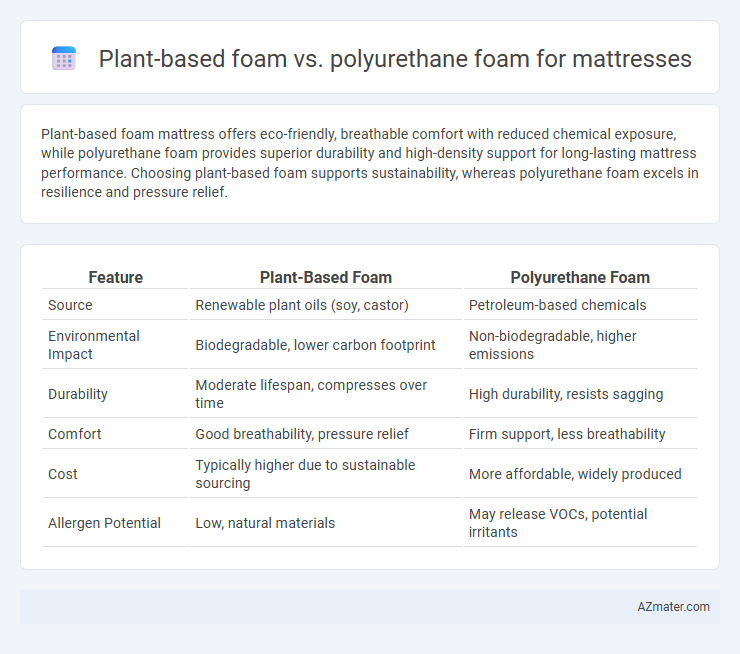Plant-based foam mattress offers eco-friendly, breathable comfort with reduced chemical exposure, while polyurethane foam provides superior durability and high-density support for long-lasting mattress performance. Choosing plant-based foam supports sustainability, whereas polyurethane foam excels in resilience and pressure relief.
Table of Comparison
| Feature | Plant-Based Foam | Polyurethane Foam |
|---|---|---|
| Source | Renewable plant oils (soy, castor) | Petroleum-based chemicals |
| Environmental Impact | Biodegradable, lower carbon footprint | Non-biodegradable, higher emissions |
| Durability | Moderate lifespan, compresses over time | High durability, resists sagging |
| Comfort | Good breathability, pressure relief | Firm support, less breathability |
| Cost | Typically higher due to sustainable sourcing | More affordable, widely produced |
| Allergen Potential | Low, natural materials | May release VOCs, potential irritants |
Introduction to Mattress Foams: Plant-Based vs Polyurethane
Plant-based foam mattresses utilize natural oils, primarily derived from soy or castor, offering enhanced breathability and reduced environmental impact compared to traditional polyurethane foams made from petrochemicals. Polyurethane foam remains popular due to its durability, support, and cost-effectiveness, but it may emit higher levels of volatile organic compounds (VOCs) during off-gassing. The choice between plant-based and polyurethane foam depends on preferences for eco-friendliness, hypoallergenic properties, and long-term comfort performance.
What is Plant-Based Foam?
Plant-based foam is a type of mattress foam partially derived from renewable natural sources such as soy, castor oil, or other plant oils, reducing reliance on petroleum-based chemicals. It offers enhanced breathability and eco-friendliness compared to traditional polyurethane foam, which is primarily synthesized from petrochemicals. This sustainable alternative provides similar support and durability while minimizing environmental impact through lower volatile organic compound (VOC) emissions and biodegradability potential.
What is Polyurethane Foam?
Polyurethane foam is a versatile synthetic material widely used in mattress manufacturing for its durability, support, and affordability. It is created through a chemical reaction between polyols and diisocyanates, resulting in a lightweight, flexible foam that conforms to the body's shape. Compared to plant-based foam, polyurethane foam often offers higher density options, providing firm support but may contain petrochemicals and emit volatile organic compounds (VOCs).
Environmental Impact: Sustainability and Biodegradability
Plant-based foam mattresses significantly reduce environmental impact by using renewable resources such as soy or castor oil, lowering reliance on fossil fuels compared to traditional polyurethane foam derived from petrochemicals. The biodegradability of plant-based foam enhances sustainability, as it breaks down more rapidly in landfills, minimizing long-term waste accumulation and reducing carbon footprint. In contrast, polyurethane foam is less biodegradable, contributing to persistent environmental pollution and resource depletion.
Comfort and Support Comparison
Plant-based foam mattresses offer enhanced breathability and pressure relief due to their open-cell structure, promoting cooler sleep and better contouring to body curves. Polyurethane foam provides denser support with higher durability but may retain heat and feel firmer, affecting comfort for side sleepers. The optimal choice depends on individual preferences for temperature regulation and the balance of softness with firm spinal support.
Health and Indoor Air Quality Considerations
Plant-based foam mattresses emit lower levels of volatile organic compounds (VOCs) compared to traditional polyurethane foams, contributing to improved indoor air quality and reduced respiratory irritation. The natural ingredients in plant-based foam often include soy, castor oil, or other renewable resources that minimize exposure to harmful chemicals commonly found in petroleum-based polyurethane foams. Choosing plant-based foam mattresses can support healthier sleep environments by lowering the risk of allergens and toxins that may impact long-term respiratory health.
Durability and Longevity of Foams
Plant-based foam mattresses offer enhanced durability due to their natural resistance to abrasion and less brittleness over time compared to traditional polyurethane foams. Polyurethane foam tends to degrade faster under constant pressure and heat, leading to sagging and reduced lifespan, typically lasting 5 to 8 years. High-density plant-based foams can extend mattress longevity beyond 8 to 10 years, maintaining consistent support and resilience throughout their use.
Cost Differences: Affordability and Value
Plant-based foam mattresses generally have a higher upfront cost compared to polyurethane foam due to sustainable sourcing and eco-friendly manufacturing processes. Polyurethane foam mattresses offer a more affordable price point, making them a popular choice for budget-conscious consumers seeking value. Despite the initial expense, plant-based foam provides long-term benefits such as durability and breathability, potentially delivering better overall value over time.
Consumer Trends and Market Demand
Consumer trends show increasing preference for plant-based foam mattresses due to their eco-friendly properties, low VOC emissions, and sustainable sourcing. Market demand for polyurethane foam remains strong because of its cost-efficiency, durability, and high-performance comfort, but the growth rate is slower compared to the rapidly expanding plant-based foam segment. The rising awareness of environmental impact and health concerns is driving mattress manufacturers to innovate and offer more plant-based foam options to meet consumer expectations.
Choosing the Best Foam for Your Mattress Needs
Plant-based foam offers increased breathability and eco-friendliness compared to traditional polyurethane foam, making it an ideal choice for environmentally conscious sleepers seeking improved airflow and temperature regulation. Polyurethane foam excels in providing consistent support and durability at a lower cost, suitable for those prioritizing affordability and long-lasting comfort. Evaluating factors such as allergen sensitivity, mattress firmness preference, and sustainability goals can help determine whether plant-based or polyurethane foam aligns best with your specific mattress needs.

Infographic: Plant-based foam vs Polyurethane foam for Mattress
 azmater.com
azmater.com